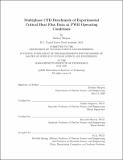Multiphase CFD benchmark of experimental critical heat flux data at PWR operating conditions
Author(s)
Skirpan, Zachary.
Download1191901232-MIT.pdf (13.36Mb)
Alternative title
Multiphase Critical Heat Flux benchmark of experimental critical heat flux data at PWR operating conditions
Other Contributors
Massachusetts Institute of Technology. Department of Nuclear Science and Engineering.
Advisor
Emilio Baglietto.
Terms of use
Metadata
Show full item recordAbstract
Critical Heat Flux (CHF) in flow boiling represents the fundamental upper limit for thermal hydraulic performance of PWR fuel. Currently, the nuclear industry relies on expensive, prototypical experiments using electrically heated, full-height rod assemblies to determine the limit of the boiling crisis. The development of next-generation Multiphase Computational Fluid Dynamics (M-CFD) approaches for the prediction of CHF seeks to represent the detailed physics of the boiling process up to its critical condition, rather than estimating it from ad-hoc thresholds. In this work we evaluate the advancement in M-CFD boiling attained by the Consortium for Advanced Simulation of Light water reactors (CASL). The CASL approach builds off an industry-lab-university collaboration with individual validation of interfacial momentum closures and wall boiling models. The M-CFD simulations were implemented in the commercially available STAR-CCM+ software, and benchmarked against experimental observations of CHF collected at the University of Wisconsin by Duarte. In this work, 15 M-CFD simulations were completed. Boiling curves were generated for each test case. The modelled boiling characteristics were then compared to expected physical parameters to determine model accuracy. Structural spacers are the main driver of vapor accumulations leading to the breakdown of boiling heat transfer at CHF. Interestingly, M-CFD solutions indicate that the Departure from Nucleate Boiling (DNB) first occurs in areas not measured by the experimental thermal couples used to detect CHF, possibly resulting in a late experimental detection. Additionally, sensitivity studies are conducted for relevant model terms to understand their impact on CHF. Leveraging the results from this sensitivity study, it is suggested that improved predictions could 1) increase the turbulent dispersion at the wall to account for turbulence under-prediction and 2) increase the minimum bubble size limiter to reflect physically observed coalesced bubble sizes after departure. For future work, higher spatial resolution measurements for detecting DNB are suggested for better experimental CHF predictions. A fully mechanistic approach for modeling the heat flux partitioning and subsequent wall boiling in M-CFD is also needed to more effectively simulate the proper heat transfer mechanisms and boiling physics before CHF. It is the hope that through this work and further M-CFD heat transfer investigations that similar methods may be validated for CHF detection and streamline the fuel design process in the nuclear industry.
Description
Thesis: S.M., Massachusetts Institute of Technology, Department of Nuclear Science and Engineering, May, 2020 Cataloged from the official PDF of thesis. Includes bibliographical references (pages 85-89).
Date issued
2020Department
Massachusetts Institute of Technology. Department of Nuclear Science and EngineeringPublisher
Massachusetts Institute of Technology
Keywords
Nuclear Science and Engineering.